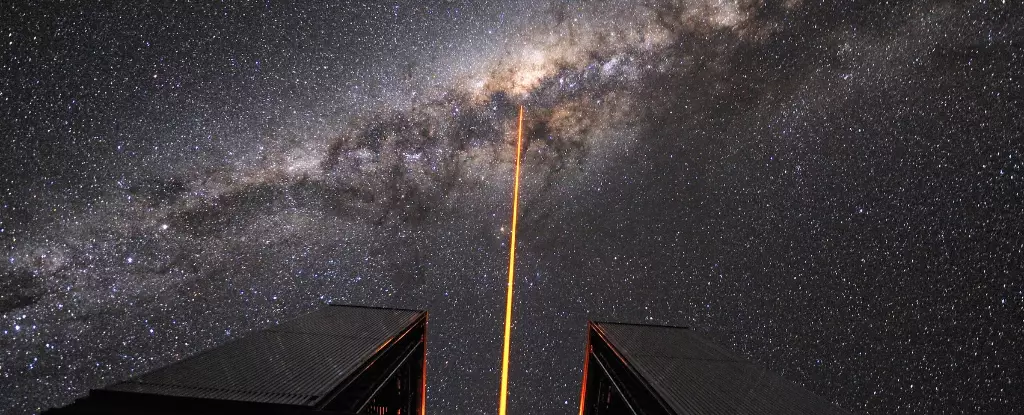At the core of our galaxy, the Milky Way, lies Sagittarius A*, a supermassive black hole that is approximately 27,000 light years away from Earth. Spanning around 23.5 million kilometers in diameter, Sagittarius A* is not only a gravitational behemoth but also a focal point of astronomical inquiry. Recently, a groundbreaking discovery was made by a team of astronomers led by Florian Peißker from the University of Cologne. They have uncovered a binary star system orbiting this enigmatic black hole, marking an unprecedented milestone in astrophysical research. This revelation not only expands our understanding of black holes but also sheds light on the dynamics of stellar movements within our galaxy.
Binary star systems consist of two stars that revolve around a common center of mass. In such systems, the gravitational interplay between the stars provides valuable data regarding their respective masses, distances, and velocities. This modern discovery is essential, as approximately 66% of stars in the Milky Way are observed to be solitary; the remainder exist as part of binary or multiple star systems. Understanding binary systems is particularly valuable to astronomers since they can infer key characteristics that are otherwise challenging to determine with solitary stars, which typically rely on luminosity to gauge mass.
Throughout history, astronomers have theorized that binary star systems should abound near supermassive black holes, yet empirical evidence had been elusive until now. The recent observations utilized the European Southern Observatory’s Very Large Telescope, where scientists made use of the Doppler effect to analyze the light emitted from the binary star system. The slight wobbling of the starlight indicated that the stars were indeed in orbit around the black hole, thus confirming the binary nature of the system.
One remarkable aspect of this discovery is the ability of the research team to ascertain that these stars are roughly 2.7 million years old. This estimation suggests that they did not originate from the hostile surroundings of Sagittarius A*, but rather emerged elsewhere in the galaxy before entering the gravitational influence of the black hole. This prolonged survival in close proximity to such a powerful gravitational force offers enlightening clues regarding the black hole’s disruptive capabilities, as it raises questions about how stars manage to maintain stability in its swirling domain.
To contextualize this within a more familiar framework, consider the Earth-Moon-Sun system, where gravity governs the relationship between these bodies. The Moon orbits the Earth, while both traverse around the Sun. This arrangement is stable due to the relatively close proximity of the Earth and Moon, creating dynamics that allow for a more predictable motion. Conversely, the interactions involving more than two bodies can lead to instabilities, which may account for the ejection of one star from a binary system—a phenomenon that could provide an explanation for the cosmic mystery of hypervelocity stars.
Hypervelocity stars, traveling at speeds exceeding 1,000 kilometers per second, are a rarity in our galaxy, with only around twenty identified since their discovery in 2005. These stars have perplexed astronomers for years due to their exceptional speeds, with most stars normally maintaining more circular and consistent orbits around the galactic center. The prevailing theory posits that hypervelocity stars could be remnants of binary systems that spiraled too close to the supermassive black hole over time. The gravitational interactions in such a scenario could lead to the expulsion of one of the stars, flinging it into the vast expanses of space at incredible velocities.
Observational data supports this theory, as many hypervelocity stars exhibit trajectories that seem to be directed away from the galactic core. However, the new findings regarding the binary star system surrounding Sagittarius A* provide a tangible pathway for further investigation into this intriguing relationship. The clear correlation between the presence of binary systems and the existence of hypervelocity stars lends substantive credibility to these theories, opening new avenues for exploration in stellar dynamics.
The discovery of a binary star system near Sagittarius A* serves as a pivotal stepping stone for understanding the complex gravitational dances taking place in the vicinity of black holes. As researchers continue to monitor this system and others like it, we may unlock further secrets of our galaxy, gaining insights into the intricate relationships between mass, gravity, and motion. The ability to observe, quantify, and analyze the elements at play in these cosmic environments bolsters our overall comprehension of astrophysics and the universe at large—an endeavor that is as challenging as it is intellectually rewarding. This significant find embodies the profound mysteries that still reside in the vast expanse of space, inviting us to explore, question, and expand our cosmic horizons.


Leave a Reply